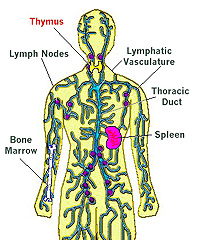|
 Lymphoid
tissue and organs, along with lymphatic vessels, constitute a
widespread immune defense and filtering system between the body
tissues (where foreign substances and organisms can gain entrance)
and the blood stream. The structure of lymphatic vessels was
considered with the circulatory system in a previous exercise. Lymphoid
tissue and organs, along with lymphatic vessels, constitute a
widespread immune defense and filtering system between the body
tissues (where foreign substances and organisms can gain entrance)
and the blood stream. The structure of lymphatic vessels was
considered with the circulatory system in a previous exercise.
This laboratory exercise will deal
primarily with lymphoid tissue, which consists of distinct lymphoid
organs (the lymph nodes, thymus, and spleen) as well as more diffuse
collections of lymphocytes (nodules), which are primarily located
along the mucosa of the digestive and respiratory tracts.
The learning objective for this
session are:
- Identify the architectural and
cellular organization of the thymus.
- Identify the structural
architecture and cellular composition of lymph nodes.
- Identify the non-encapsulated
collections of lymphoid tissue associated with the
gastrointestinal tract (GALT) and explain their functions:
tonsils, Peyer's patches, and appendix.
- Identify the connective tissue
capsule, trabeculae, white and red pulp in spleen and components
of the blood circulation in the spleen.
The actors. |